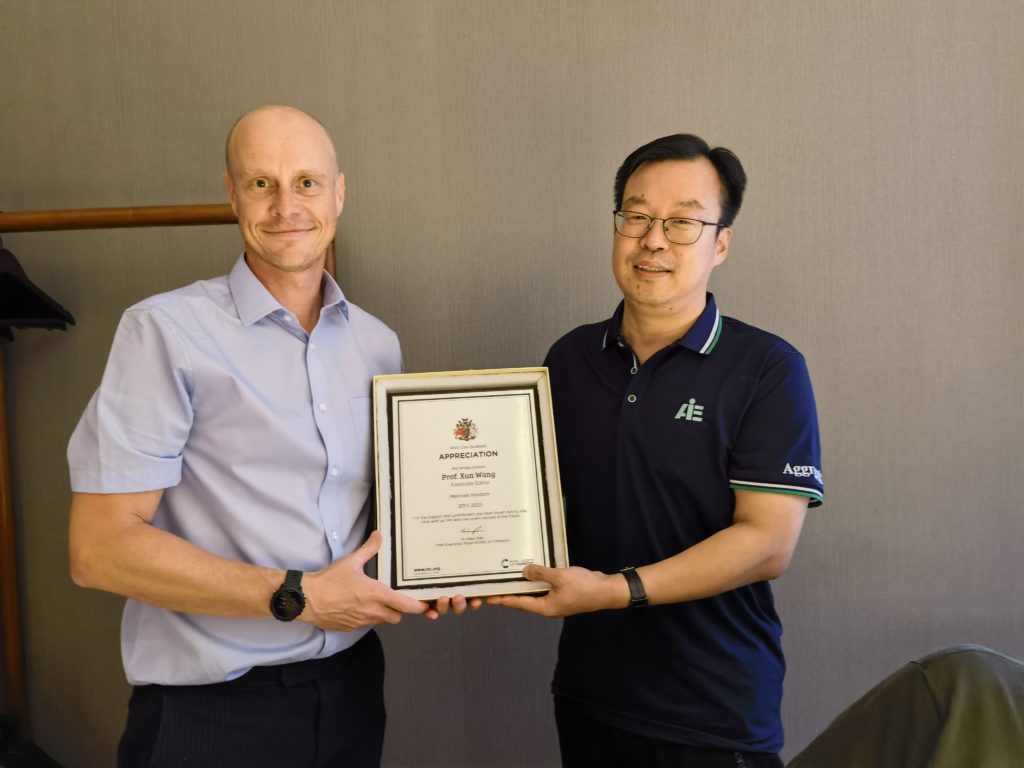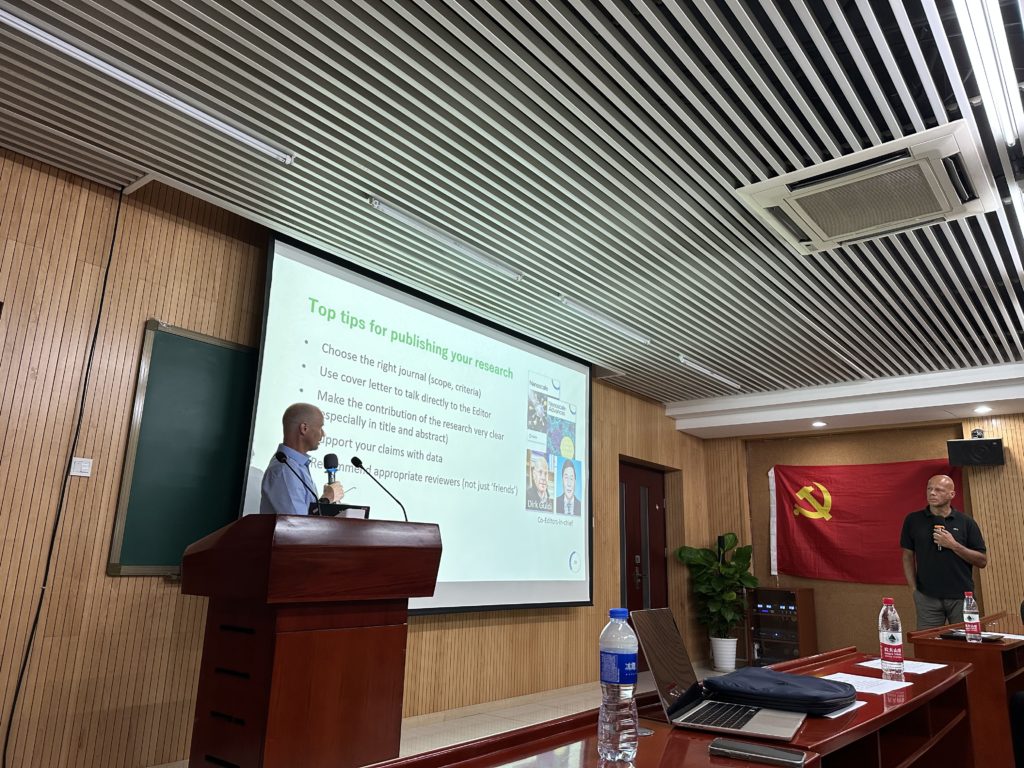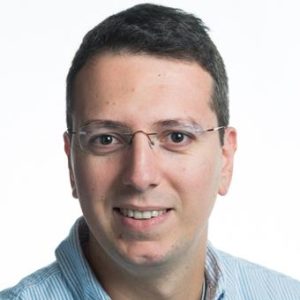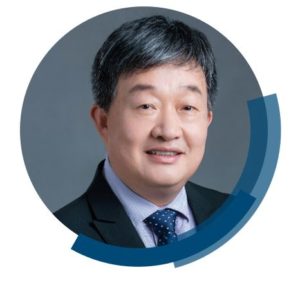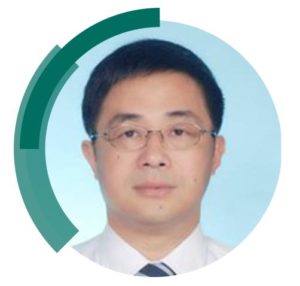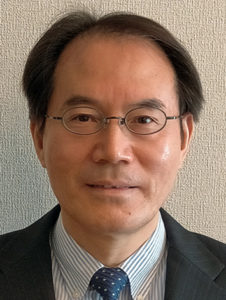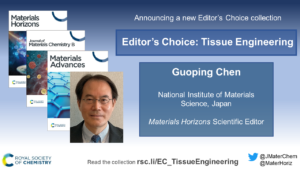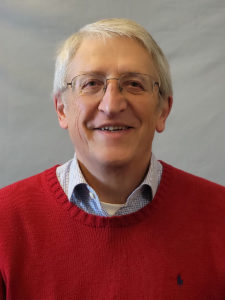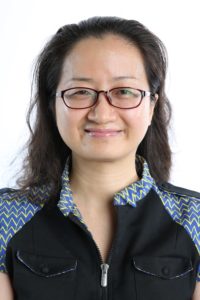Professor Xun Wang, former Scientific Editor of Materials Horizons, was presented with a certificate of appreciation by Publisher Neil Hammond on 30 August (above photo). The certificate was given at a dinner after a visit to Tsinghua University, China. Professor Quanming Wang, the Vice Dean of the Chemistry department, hosted the visit to Tsinghua University and chaired the talks. Nanoscale Horizons Scientific Editor Dirk Guldi presented the scientific talk followed by a joint publishing talk with Publisher Neil Hammond (below photo).
Archive for the ‘Editorial Board’ Category
Materials Horizons introduces two new Editorial Board members
Welcome Simone Fabiano and Kelsey Hatzell to the Materials Horizons Editorial Board
Materials Horizons is pleased to announce the addition of two new board members, Simone Fabiano and Kelsey Hatzell. We would like to welcome you both to the fantastic team who support the publication of high-quality and innovative research from across the globe. We have provided a short bio below to introduce Simone and Kelsey to our community.
Simone Fabiano, Scientific Editor
Linköping University, Sweden
Simone Fabiano is an associate professor and docent in Applied Physics at Linköping University, Sweden. He obtained his PhD in Chemistry from the University of Palermo in 2012. During his doctoral studies, he was a visiting scholar at the Zernike Institute for Advanced Materials of the University of Groningen, The Netherlands. He then held postdoctoral positions at both Linköping University (2012-2015) and Northwestern University (2016-2017) before returning to Linköping University to establish his research group. In 2020, he founded n-Ink AB, a spinout company that focuses on developing n-type organic conductive inks, where he serves as the Chief Scientific Officer. His group at Linköping University primarily focuses on developing organic dopant-free conductors and mixed ionic-electronic conductors for printed electronics and neuromorphic hardware applications. He has received several awards, including the Swedish Research Council Starting Grant in 2017 and Consolidator Grant in 2023. He is also a Wallenberg Academy Fellow.
Kelsey Hatzell, Editorial board member
Princeton University, USA
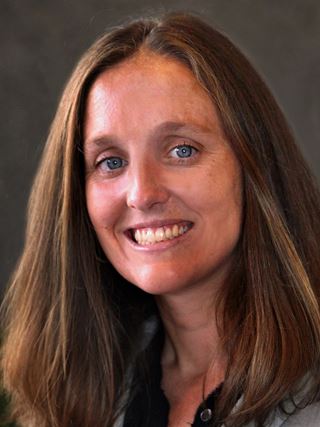 |
‘I look forward to intersecting more with the Royal Society of Chemistry and the editors and editorial board of Materials Horizons. In addition, I’m very excited to learn more about Materials Horizons and its readership. It is really a privilege to play a role in the future directions of Materials Horizons.’ |
Dr. Hatzell is an assistant professor at Princeton University in the Andlinger Center for Energy and Environment and Department of Mechanical and Aerospace engineering. Hatzell’s group primarily work on energy storage and is particularly interested at using non-equilibrium x-ray techniques to probe materials for energy and separation applications. Hatzell earned her Ph.D. in Material Science and Engineering at Drexel University, her M.S. in Mechanical Engineering from Pennsylvania State University, and her B.S./B.A. in Engineering/Economics from Swarthmore College. Hatzell’s research group works on understanding phenomena at solid|liquid, solid|gas, and solid|solid interfaces broadly work in energy storage and conversion. Hatzell is the recipient of several awards including the ORAU Powe Junior Faculty Award (2017), NSF CAREER Award (2019), ECS Toyota Young Investigator Award (2019), finalist for the BASF/Volkswagen Science in Electrochemistry Award (2019), the Nelson “Buck” Robinson award from MRS (2019), Sloan Fellowship in Chemistry (2020), and POLiS Award of Excellence for Female Researchers (2021), NASA Early Career Award (2022) and ONR Young investigator award (2023).
Please join us in welcoming Simone Fabiano and Kelsey Hatzell to the Materials Horizons Editorial Board. We encourage you to submit your best work to Simone, Kelsey and our team of Editorial board members now! Check out the Materials Horizons author guidelines for more information on our article types.
Introducing Zhongyi Jiang as a new Scientific Editor on Materials Horizons
Materials Horizons are delighted to welcome Professor Zhongyi Jiang from Tianjin University in China as a Scientific Editor.
Zhongyi Jiang is a Professor in the School of Chemical Engineering and Technology at Tianjin University. He received his PhD degree from Tianjin University (China) in 1994. He was a visiting scholar of University of Minnesota with Prof. Edward Cussler in 1997 and California Institute of Technology with Prof. David Tirrell in 2009. He is the winner of National Science Fund for Distinguished Young Scholars in China, the Cheung Kong Chair Professor and the Fellow of the Royal Society of Chemistry.
His group is interested in biomimetic and bioinspired membranes and membrane processes, biocatalysis, photocatalysis. He has co-authored over 600 publications. He is selected on the list of highly cited scholars (chemical engineering) in China and the list of highly cited scholars (chemical engineering) in the world.
Check out some of Professor Jiang’s publications in Royal Society of Chemistry journals:
Multi-stepwise electron transfer via MOF-based nanocomposites for photocatalytic ammonia synthesis
Hanjie Ren, Jiangdan Tan, Zhanfeng Zhao, Yonghui Shi, Xin Xin, Dong Yang and Zhongyi Jiang
Catal. Sci. Technol., 2022, 12, 5540-5548 DOI: 10.1039/D2CY01086K
Ultra-robust, highly proton-conductive polymer carbon dot membranes through bioinspired complexation
Benbing Shi, Xiao Pang, Hong Wu, Jianliang Shen, Jingyuan Guan, Xiaoyao Wang, Chunyang Fan, Li Cao, Tianhao Zhu, Zhuoyu Yin, Yan Kong, Yiqin Liu, Sijia Wang and Zhongyi Jiang
J. Mater. Chem. A, 2022, 10, 16995-17000 DOI: 10.1039/D2TA02460H
Multi-stepwise charge transfer via MOF@MOF/TiO2 dual-heterojunction photocatalysts towards hydrogen evolution
Yao Chen, Dong Yang, Xin Xin, Zhongshan Yang, Yuchen Gao, Yonghui Shi, Zhanfeng Zhao, Ke An, Wenjing Wang, Jiangdan Tan and Zhongyi Jiang
J. Mater. Chem. A, 2022,10, 9717-9725 DOI: 10.1039/D1TA10270B
Join us in welcoming Professor Zhongyi Jiang to our Editorial Boards!
Submit to Materials Horizons now! Check out our author guidelines for information on our article types or find out more about the advantages of publishing in a Royal Society of Chemistry journal.
Keep up to date with our latest articles, reviews, collections & more by following us on Twitter, Facebook or by signing up to our E-Alerts.
Introducing Yong Cui as a new Scientific Editor on Materials Horizons
Materials Horizons are delighted to welcome Professor Yong Cui from Shanghai Jiao Tong University in China as a Scientific Editor.
Yong Cui received his PhD in 1999 from Fujian Institute of Research on the Structure of Matter, Chinese Academy of Sciences, and conducted postdoctoral research at the University of Science and Technology of China, University of North Carolina at Chapel Hill and University of Chicago from 1999 to 2005. He joined School of Chemistry & Chemical Engineering, Shanghai Jiao Tong University in 2005, where he is now a chair professor of chemistry. He is a Fellow of the Royal Society of Chemistry. His research interest focuses on the design and synthesis of porous materials, especially frameworks materials and chiral materials, for catalysis, adsorption, separation, sensing and optics.
Read our interview with Yong below.
1. Why did you choose to specialize in your specific research field?
Nature makes pervasive use of homochirality (e.g., D-sugars and L-peptides) to assemble biomolecules, whose interactions determine life processes, while biological homochirality is still one of the major unsolved problems in science. My research interest is thus focused on the design and development of chiral crystalline materials through hierarchical self-assembly of suitably designed chiral building blocks, with the aim to fundamentally understanding how molecular-scale chirality could be significantly transmitted and amplified across differing length scales. Eventually, we aim to develop useful chiral materials with unexpected advantages relevant to materials science, molecular biology, nanotechnology and precision medicine.
2. What do you see as the biggest challenges facing researchers who work in your field?
Frankly speaking, there are lots of challenges and difficulties in this field. If I have to choose the biggest one, I think it should be how to rationally design and precisely synthesize chiral materials enabling outstanding enantioselective performance that could compare with (even beyond) natural systems.
3. What excites you most about your area of research and what has been the most exciting moment of your career so far?
One of the most exciting moments of my research was when we developed a new type of 2D materials that were achieved through exfoliation of molecule crystals. Against expectation, the free-standing homochiral monolayer crystallites rely purely on weak non-covalent forces to maintain their integrity. Our finding suggests the possibility of greatly increasing the range and diversity of 2D materials.
The most exciting moment of my career have always been related to my students who get really exciting experimental results or discover new experimental phenomena etc. I am very proud of my students who will continue to devote themself to scientific research.
4. What has been the most challenging moment of your career so far?
The most challenging moment should be the supervision of a research group, either a small or big team, but this process seems to be very rewarding. Looking back now, I was very lucky to have lots of incredible advisors, colleagues, and friends, who taught me how to be an independent scientist. I’m also grateful for working with those talented students and I really hope they have enjoyed their time in my research group.
5. Which of your Royal Society of Chemistry publications are you most proud of and why?
I would have to say that I love them all. We spend many times and make great efforts for these fundamental researches. However, if I have to select one piece of them, it would probably be the research regarding the design and synthesis of a homochiral Cr-salen-based MOF for catalysing broad-scope asymmetric transformations, including the Nazarov cyclization, aminolysis reaction, and Diels–Alder and hetero Diels–Alder reactions. This work demonstrates the superior reactivity of Cr-salen embedded crystalline porous materials, which represents an important step towards practical applications.
6. Why do you feel that researchers should choose to publish their work in Materials Horizons?
Materials Horizons is a high-profile, prestigious journal publishing rigorously peer-reviewed research across broad-scope disciplines. The high impact factor (up to 15.717) of this journal is indicative of that the editorial community are leading this journal to the cutting-edge research directions. That’s important for researchers, knowing that you are publishing your work in an ascending journal with strong reputation.
7. What attracted you to join the Editorial Board of Materials Horizons?
The editorial board of Materials Horizons has done a great job in attracting high-quality and innovative material science research. I believe that I could help to further improve the impact of Materials Horizons and help to expand the scope of readers in China. I can see this would be a golden opportunity for me to learn how to participate and promote the development of Materials Horizons and engage the communication between the editorial board and the authors. I’m very happy to work as a board member to make Materials Horizons as one of the most exciting and high impact journals.
Submit to Materials Horizons now! Check out our author guidelines for information on our article types or find out more about the advantages of publishing in a Royal Society of Chemistry journal.
Keep up to date with our latest articles, reviews, collections & more by following us on Twitter, Facebook or by signing up to our E-Alerts.
Materials Horizons welcomes Professor Guoping Chen to the Editorial Board
Materials Horizons are delighted to welcome Professor Guoping Chen from the National Institute for Materials Science in Japan to the Editorial Board as a Scientific Editor.
Guoping Chen is a Group Leader at the National Institute for Materials Science (NIMS) and a Professor at the University of Tsukuba. He received his Ph.D. from Kyoto University in 1997 majoring in polymer biomaterials and did postdoctoral research until 2000. He joined the Tissue Engineering Research Center, National Institute for Advanced Industrial Science and Technology as a Researcher in 2000 and a Senior Researcher in 2003. He moved to the Biomaterials Center, NIMS as a Senior Researcher in 2004 and was promoted to Group Leader in 2007. He served as a Principal Investigator and Unit Director of the International Center for Materials Nanoarchitectonics (MANA), NIMS from 2011 to 2017. He concurrently joined the Joint Doctoral Program in Materials Science and Engineering, University of Tsukuba as an Associate Professor in 2004 and a Professor in 2013. He is a Fellow of the Royal Society of Chemistry (FRSC, 2015), the American Institute for Medical and Biological Engineering (AIMBE, 2017) and the International Union of Societies for Biomaterials Science and Engineering (FBSE, 2020). His research focuses on biomaterials, scaffolds, biomimetic matrices, micro-patterning, surface modification, tissue engineering, regenerative medicine and nanomedicine.
Check out Guoping Chen’s lab webpage here to find out more about his research.
Guoping Chen joins the Materials Horizons Editorial Board after previously having an Associate Editor role on Journal of Materials Chemistry B and Materials Advances. To mark this transition, he has selected some outstanding recent articles and reviews on the topic of tissue engineering across Materials Horizons, Journal of Materials Chemistry B and Materials Advances. We welcome you to read this Editor’s Choice collection on tissue engineering and check out the Editorial written by Guoping Chen to introduce the collection.
Read our interview below to find out more about Guoping:
1. What attracted you to pursue a career in materials science and how did you get to where you are now?
I have been interested in almost anything since I was a kid. I could imagine something that I did not know or had never seen. Such curiosity had driven me to show more interest on materials science after entering high school. During college study, I spent a lot of time doing experiments. By doing experiments, I found materials science more and more interesting. So, I decided to enter materials science field when I entered graduate school in 1986. Since then, I have been involved in this field for more than 36 years. Now, doing scientific experiments to synthesize new materials and to discover new phenomena has become one of my interests. My curiosity and persistence have brough many benefits to my research career.
2. Why did you choose to specialize in your specific research field?
From 1994 to 1997, I did my Ph.D. study at Department of Materials Chemistry of Kyoto University majoring in biomaterials. After graduation, I got two offers. One was tissue engineering research and the other was synthesis of stimuli-responsive polymers and actuators. I chose the first one because I thought I could challenge more new things in the interdisciplinary field of materials science and biological science. So, I joined the tissue engineering research group of a national research institute. Since then, I have been enjoying working in the field.
3. What do you see as the biggest challenges facing researchers who work in your field?
Many advanced approaches have been developed for regeneration of functional tissues and organs through materials science, biomimetics, synthetic chemistry, biomechanics and cell biology. In some cases, very complicated approaches have been proposed and used. Sometimes I think the system of our body may not be as complex as we think. There may be some switches to reveal the simple way that our body uses to assemble all cells and components together into functional tissues and organs. Finding the switches and learning from the natural assembly clues to create multi-functional biomaterials and scaffolds may be the biggest challenges in my research field.
4. What do you see as the most important scientific achievement of the last decade?
I think it is CRISPR gene editing. It provides a cheap and easy way to precisely edit DNA. It is attractive for the treatment of refractory diseases such as cancer, HIV and genetic diseases.
5. What excites you most about your area of research and what has been the most exciting moment of your career so far?
Multi-functional scaffolds are amusing because they are similar to the housing where cells live. They can provide a variety of physicochemical, biological, biomechanical and therapeutic signal and factors to guide functional tissue regeneration, to maintain cellular homeostasis and to treat diseased cells. The most exciting moment for me was in 2000 when I succeeded in preparing hybrid scaffolds of biodegradable synthetic polymers and naturally derived polymers. The hybrid scaffolds have high mechanical strength and good biocompatibility and can be used for regeneration of large tissues such as large cartilage for treatment of osteoarthritic cartilage defects. The research had been introduced twice by Nature BioNews.
6. What is your favourite reaction or material, and why?
Biomimetic materials are very attractive to me. If we can mimic the compositions, structures and processes of tissue and organ development, we can more easily control cell functions and tissue regeneration.
7. The Journal of Materials Chemistry B and Materials Advances Editorial Boards are sad to see you leave but are excited for your new role. What will you miss most about being an Associate Editor on Journal of Materials Chemistry B and Materials Advances?
I’m really proud to have joined the editorial team to work for Journal of Materials Chemistry B for nine years shortly after the JMC split and to work for Materials Advances since its launch. I appreciate the strong support and help from the great team. I am very happy to have worked with all colleagues. I had a lot of happy times and good memories during the daily editorial work, the editorial board meetings in Cambridge and RSC Editors’ Symposium in London. I have had many opportunities to communicate with our authors and reviewers. I will miss them very much. I hope they will continue to support the journals by publishing their excellent research achievements in the journals and providing excellent reviewing services for the journals.
8. What attracted you to join the Editorial Board of Materials Horizons?
I often read the articles published in Materials Horizons. The high quality of the articles has given me an impression that the editorial team is always doing a great job to edit the best articles for the readers. Now I am very happy to join the team to make some contributions.
9. The Materials Horizons team are delighted to welcome you to the Editorial Board. What are you most looking forward to when acting as a Scientific Editor for the journal?
I will fully use my previous editorial experience to provide the best service to satisfy our authors and readers.
10. What is your biggest passion outside of science?
I like jogging and cooking. After my daily work, I go jogging in a park at night. It is my happiest moment because I can relax more and think of some new research ideas while enjoying the natural night view. If time permits, I also cook because cooking is like doing chemical experiments. There are raw materials, processes and final products. There are a lot of fun.
11. Why should young people study chemistry or related subjects?
Chemistry can help us to understand the essence of nature and to synthesize novel and functional compounds and materials for innovation. Chemistry is the fundamental and central science for many fields including materials science and biological science.
12. What impact do you feel that your area of research can make over the next 10 years?
Many new techniques such as biomimetics, bioprinting and hybridization have been developed for scaffold preparation and functionalization. Advanced scaffolds with more biomimetic structures and functions will be achieved for the regeneration of not only simple tissues, but also complex organs. Multi-functional scaffolds will provide synergistic effects of different therapeutic treatments and regenerative approaches.
Please join us in welcoming Professor Guoping Chen to the Materials Horizons Editorial Board. We encourage you to submit your best work to Guoping and our team of Scientific Editors now! Check out the Materials Horizons author guidelines for more information on our article types.
Introducing Jean-Luc Brédas as a new Scientific Editor on Materials Horizons
Materials Horizons are delighted to welcome Professor Jean-Luc Brédas from the University of Arizona, USA as a Scientific Editor.
Professor Jean-Luc Bredas received his B.Sc. (1976) and Ph.D. (1979) degrees from the University of Namur, Belgium. In 1988, he was appointed Professor at the University of Mons, Belgium, where he established the Laboratory for Chemistry of Novel Materials. While keeping an “Extraordinary Professorship” appointment in Mons, he joined the University of Arizona in 1999. In 2003, he moved to the Georgia Institute of Technology where he became Regents’ Professor of Chemistry and Biochemistry and held the Vasser-Woolley and Georgia Research Alliance Chair in Molecular Design. Between 2014 and 2016, he joined King Abdullah University of Science and Technology (KAUST) as a Distinguished Professor and served as Director of the KAUST Solar & Photovoltaics Engineering Research Center. He returned to Georgia Tech in 2017 before moving back to the University of Arizona in 2020 where he is currently Regents Professor in the Department of Chemistry and Biochemistry. Jean-Luc Brédas is an elected Member of the International Academy of Quantum Molecular Science, the Royal Academy of Belgium, and the European Academy of Sciences. Recent honors include the 2013 American Physical Society David Adler Lectureship Award in the Field of Materials Physics, the 2016 American Chemical Society Award in the Chemistry of Materials, the 2019 Alexander von Humboldt Research Award, the 2020 Materials Research Society Materials Theory Award, and the 2021 Centenary Prize of the RSC. He is an Honorary Professor of the Institute of Chemistry of the Chinese Academy of Sciences and holds an Adjunct Professorship at the Georgia Institute of Technology. His Focus Article “Mind the Gap” is the first article that appeared in the very first issue of Materials Horizons.
Read our interview with Jean-Luc below.
1. What attracted you to pursue a career in materials science and how did you get to where you are now?
It was initially a love for chemistry, which grew into a passion for computational chemistry and organic chemistry. With organic materials becoming increasingly appealing because of their opto-electronic properties and broad range of applications, I gradually evolved into a computational materials scientist.
2. Why did you choose to specialize in your specific research field?
Because of a major scientific event that took place as I was starting my Ph.D.: The then-surprising discovery by Alan Heeger, Alan McDiarmid, and Hideki Shirakawa in late 1976 that organic polymers can be made highly electrically conducting, which led to the 2000 Nobel Prize in Chemistry. That discovery is what decided where I wanted to do my post-doc and everything else followed from there.
3. What do you see as the most important scientific achievement of the last decade?
Given the pandemic context, the development of m-RNA based vaccines springs to mind. In my field, the emergence of bio-organic electronics is very exciting as well as that of organic-inorganic hybrid perovskites.
4. What excites you most about your area of research and what has been the most exciting moment of your career so far?
The fact that the area of organic electronics and photonics combines the need for understanding of fundamental scientific processes with real-world applications: OLED displays are so cool!
5. Which of your Materials Horizons publications are you most proud of and why?
It turns out that I signed the very first article published by the journal in early 2014: “Mind the Gap”. It was a Focus Article, which many told me has been very useful to get clear ideas of the distinctions among band gap, optical gap, transport gap, etc.
6. Why do you feel that researchers should choose to publish their work in Materials Horizons?
Because of the journal’s high standards; because their work is initially assessed by scientific editors who are fellow active researchers; and because the journal highlights the new conceptual advances that the authors’ quality work brings forward.
7. What attracted you to join the Editorial Board of Materials Horizons?
I was a member of the original Editorial Advisory Board of the journal. I was seduced by the vision that the then Chair of the Editorial Board, Seth Marder, brought to what has become the flagship materials journal of the RSC. I am happy now to be in a position to contribute more directly.
8. The Materials Horizons team is delighted to welcome you to the Editorial Board. What are you most looking forward to when acting as a Scientific Editor for the journal?
What I hope to contribute is to a healthy growth of the journal where we strive to keep increasing its high standards, to make sure all members of the materials community are actively involved in its evolution, and to promote respect, diversity, and inclusion in everything we do for the journal.
9. What impact do you feel that your area of research can make over the next 10 years?
The application of organic optoelectronics on the bio side and its contributions to personalized medicine as well as to healthcare in developing countries. The appearance of organic solar cells out in the real world. The discovery of exotic quantum phases in purely organic π-conjugated materials.
10. What is your favourite reaction or material, and why?
I’ll have to say trans-polyacetylene, even though it is not a polymer that will have big-time applications given its instability. However, this is the material that arguably started the interest in the optoelectronic properties of organics. Also, the wealth of physics behind its deceivingly simple chemical structure is amazing!
11. Why should young people study chemistry or related subjects?
The events of the past two years as well as the dark issues facing our planet, make it more important than ever that the young generations embark on scientific studies, combined with the right political activism.
12. What is your biggest passion outside of science?
My family and soccer. It is a blast that both our daughters now live in Tucson and we can see them very often. Soccer-wise, it is nice to realize that the US are increasingly embracing the “beautiful game”; it’s comforting as well that “I’ll never walk alone”.
Submit to Materials Horizons now! Check out our author guidelines for information on our article types or find out more about the advantages of publishing in a Royal Society of Chemistry journal.
Keep up to date with our latest articles, reviews, collections & more by following us on Twitter, Facebook or by signing up to our E-Alerts.
Introducing Yi Long as a new Scientific Editor on Materials Horizons
Materials Horizons are delighted to welcome Dr Yi Long from Nanyang Technological University in Singapore as a Scientific Editor.
Yi Long received her PhD in Materials Science (2005) at Cambridge University with the full scholarship of Overseas Research Scholarship (ORS), United Kingdom Cambridge Trust and Graduate Scholarship of Selwyn College. She started as a Teaching Fellow in Nanyang Technology University Singapore in 2005 with focus on Lab-to-Fab technology transfer for industries. She successfully delivered three technologies include one coating process to Seagate Technology, the leading hard-disk company in the world. From 2011, she changed her title as lecturer and started her academic research center on smart materials and devices.
Her group currently focuses on two main topics; the integration of organic and inorganic smart materials with (1) energy saving applications, and (2) novel advanced functional devices. She has received several awards including the TechConnect Innovation Washington (2016), National Research Foundation Proof of Concept grant (2015), Minister of Education Tier 2 (2021), GreenAwards Top 3 London (2022). She is a Fellow of the Royal Society of Chemistry.
Read our interview with Yi below.
1. What attracted you to pursue a career in materials science and how did you get to where you are now?
My first degree is mechanical design with some courses covering materials fabrication, property, and utilization. When I was offered a scholarship in Singapore, I specialized in electronic materials. I enjoyed the process of making a new piece of material as it felt like creation. After my masters training, I worked as a lithography engineer in a top semiconductor company with good job potential, but a full overseas research scholarship by Cambridge University attracted me. Without much hesitation, I quitted my industrial job and my long journey of research embarked. My PhD training was using self-made ultra-high vacuum system to fabricate superlattice structure and studying its strengthening mechanism. It was tough. I remembered my daily lab work, spending two days carrying 10 KG flange to deposit one single sample and many hours in the dark TEM room to fathom why. My supervisor Dr. Bill Clegg was passionate about research. He sat next door and greeted us every morning cheerfully “Anything new?”. The PhD training did lay a solid foundation. What made it more unforgettable was pubbing, garden party and formal halls.
2. Why did you choose to specialize in your specific research field?
I have a unique career. Different from many researchers, after I graduated from Cambridge, I did not attend postdoc training. I was offered a job in Singapore as a teaching fellow to reunion with my husband-to-be. For the first six years of my career in Singapore, I focused on transferring technologies to local industries. I am happy that I have succeeded a few including one solution coating process to Seagate Technologies, the leading hard disk company in the world. After four years of hard work, a production line was set up. Although such work gave zero publications, it was rewarding. Industry and academic speak different languages. I am lucky that I am bilingual.
In 2011, I changed my title to Lecturer and was awarded one research program by National Research Foundation Singapore to specialize in thermochromic smart window. It was a humble beginning, with only one part time PhD student funded for the first three years. Like all the other colleagues in the world, the beginning is always most gruelling.
3. What do you see as the most important scientific achievement of the last decade?
This is a big question. I could only say, in my own research field, radiative cooling could be considered as one of the important as it spontaneously radiate long-wave infrared to the cold outer space. This could be one of the important solutions to global warming. There are many pioneer workers there, Profs. Fan Shangkui, Yin Xiaobo, Hu Liang Bing, Yang Ronggui and many more. The research community never stops exploration. “Don’t be afraid of boundless truth, there always exists joy in any step taken.” (Dr Hu Shih, Public Intellectual)
4. What excites you most about your area of research and what has been the most exciting moment of your career so far?
Buildings consume about 40% of global energy and window, one of the least energy-efficient parts, accounts for as high as 60% of energy loss in the buildings. In the United States, the window-associated energy consumption in buildings was estimated at 4% of nation’s total primary energy usage. The potential that I may contribute to this grand challenge excites me.
We started our research with radiative cooling regulated window in 2019. At the initial proof of concept stage, we designed outdoor experiment to convince that we were in the right track. Singapore is a tropical country. The data for summer season were readily accessible and predictably good. We need find a place to simulate the winter scenario. Singapore has a Snow City with the indoor temperature below -5 oC. We asked the special permission to do the experiment before the opening hour. My students Dr. Wang ShanCheng and Zhou Yang had to finish everything within 3 hours. When we saw the “room temperature” was higher than the commercial product, the three of us were thrilled. The day after we finished the experiment, the Snow City was sadly closed due to Covid lockdown.
5. What is your favourite reaction or material, and why?
Vanadium dioxide and hydrogel. Both have profound science behind and great potential to be commercialized. I have spent one decade, trying hard to understand them more. Both materials are smart as they could give fascinating response with external stimulus automatically. I worked with heat stimulus most of the time. Such passive response of these two materials simply the device design and cut down the cost. Less is more.
6. Which of your Materials Horizons publications are you most proud of and why?
Materials Horizons 8 (6), 1700-1710, 2021. Vanadium dioxide (VO2) is a unique active plasmonic material due to its intrinsic metal–insulator transition, Dr Ke Yujie, my PhD student, experimented a new method to tailor the VO2 surface plasmon by manipulating its atomic defects. With the excellent collaboration with Prof. Sun Zhimei, this paper developed a quantitative understanding based on different representative defective VO2 systems. We further demonstrated the unconventional plasmonic applications including energy-saving smart windows, wearable camouflage devices, and encryption inks.
7. What attracted you to join the Editorial Board of Materials Horizons?
My submissions to Materials Horizons were not all smooth. I remembered one of them had one negative comment and the paper was rejected initially. I appealed and the editorial DID listen. The editorial team is professional and open minded. I admire profoundly.
8. What is your biggest passion outside of science?
Reading and Movies. When I was young, there were not much entertainment, reading and watching movies were my hobbies. Science is more about logical and rational reasoning. Humanities is about empathic understanding. I need balance my academic life with other horizons. We human can “see” the black holes, navigate the deepest sea, transmit data in light speed and even transform ourselves into immortal cyborg. How about humanity?
9. Why should young people study chemistry or related subjects?
Creation. We synthesis, characterize and analyse. Materials shape the evolution of human civilization from Stone, Bronze, Iron to Silicon. What is next? It’s open to generations of materials scientists.
10. What impact do you feel that your area of research can make over the next 10 years?
Paris treaty aims to hold the increase in the global average temperature to “well below” 2°C above pre-industrial levels. It is our scientist moral obligation and social responsivity to take actions. My research is focused on smart materials and device, but majority work is with smart window. There is not much technological advancement of commercial windows for many years. I do hope more breakthroughs could happen to bring the new window in the household with more functionality and much less carbon footprint.
Submit to Materials Horizons now! Check out our author guidelines for information on our article types or find out more about the advantages of publishing in a Royal Society of Chemistry journal.
Keep up to date with our latest articles, reviews, collections & more by following us on Twitter, Facebook or by signing up to our E-Alerts.
Editorial Board Chair Seth Marder awarded Humboldt Research Award
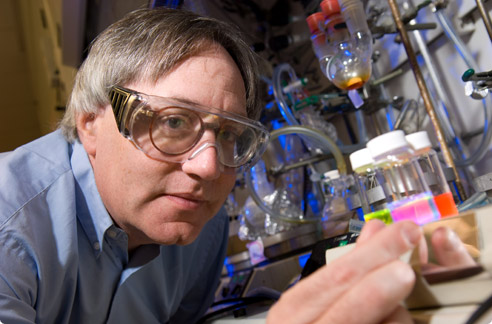 Congratulations to Professor Seth Marder, Georgia Institute of Technology and Materials Horizons founding Editorial Board Chair. He has been elected as the recipient of a Humboldt Research Award from the Alexander von Humboldt Foundation.
Congratulations to Professor Seth Marder, Georgia Institute of Technology and Materials Horizons founding Editorial Board Chair. He has been elected as the recipient of a Humboldt Research Award from the Alexander von Humboldt Foundation.
The award is granted in recognition of a researcher’s entire achievements to date to academics whose fundamental discoveries, new theories, or insights have had a significant impact on their own discipline and who are expected to continue producing cutting-edge achievements in the future. Seth is internationally recognized for his leadership in developing structure-property relationships for organic and metallo-organic materials for optical and electronic applications.
Award winners are invited to spend a period of up to one year cooperating on a long-term research project with specialist colleagues at a research institution in Germany. As part of his award, Seth will be hosted as a visiting researcher by Professor Norbert Koch at IRIS Adlershof and the Department of Physics of Humboldt-Universität zu Berlin.
Introducing the Materials Horizons Community Board
Materials Horizons is thrilled to announce that the first researchers have joined our Materials Horizons Community Board. This board is unique in that it is made up of early career researchers, such as PhD students and postdocs, that are fundamental in the future development of the materials field.
This board will help build relationships with the young researcher community, providing the editorial office with not only essential feedback and advice on the perception of the journal in their community but also education-focused initiatives that will benefit the materials community as a whole.
These engaged and enthusiastic researchers have been nominated by the Materials Horizons and Journal of Materials Chemistry A, B & C Editorial and Advisory Board. We received several excellent nominations and the successful candidates are:
- Sarit Agasti – Jawarhal Nehru Center for Advanced Scientific Research, India
- Athina Anastasaki – Warwick University, UK
- Robert Chapman – Imperial College London, UK
- Chaohua Cui – Soochow University, China
- Rebecca Gieseking – Northwestern University, USA
- Peter Korevaar – Harvard University, USA
- John Labram – University of California, Santa Barbara, USA
- Tian-Yi Ma – University of Adelaide, Australia
- Jaime Martín Pérez – Imperial College London, UK
- Troy Townsend – St Mary’s College of Maryland, USA
- Daiki Umeyama – Stanford University, USA
- Mengye Wang – Xiamen University, China
Please join us in congratulating the new members of the Materials Horizons Community Board.
Bruno Chaudret is our new Scientific Editor

Materials Horizons would like to welcome Bruno Chaudret as our newest Scientific Editor.
Bruno has a wealth of experience having co-authored over 400 publications and being the recipient of several prizes including the Gay-Lussac – Humboldt Prize and the Wilkinson Prize of the RSC. He graduated from École Nationale Supérieure de Chimie de Paris in 1975 and then went on to receive his Ph.D. from Imperial College London in 1977 with Sir Geoffrey Wilkinson. He was awarded the degree of a “Docteur ès Sciences” at the University of Toulouse in 1979.
He is now “Director of Research CNRS”, Director of the “Laboratoire de Physique et Chimie des Nano-Objets” in Toulouse and a member of the French Academy of Science since 2005.
His interests have been in the chemistry of hydride and dihydrogen organometallic complexes, and in the early 90s, he developed an organometallic method for the synthesis of metal or metal oxide nanoparticles.
We very much look forward to working with him!


